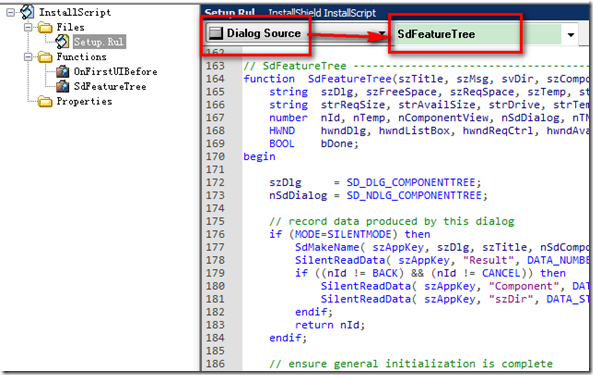1.工程说明
在实际应用中,有 InstallSrcipt MSI 和 InstallSrcipt 这两个工程最常用,基本上脚本是可以共用的,
但是有个不同:
在 InstallSrcipt MSI 中,安装路径可以使用 INSTALLDIR 和 TARGETDIR,
而在 InstallSrcipt 中,只能使用TARGETDIR。
这里 InstallSrcipt 说明,记录使用过程中遇到的问题。
2.License选择
在 OnFirstUIBefore中,已经为工程自定义了许可文件license页面,脚本代码如下::
Dlg_SdLicense2: szTitle = ""; szOpt1 = ""; szOpt2 = ""; //{{IS_SCRIPT_TAG(License_File_Path) szLicenseFile = SUPPORTDIR ^ "License.rtf"; //}}IS_SCRIPT_TAG(License_File_Path) //{{IS_SCRIPT_TAG(Dlg_SdLicense2) nResult = SdLicense2Ex( szTitle, szOpt1, szOpt2, szLicenseFile, bLicenseAccepted, TRUE ); //}}IS_SCRIPT_TAG(Dlg_SdLicense2) if (nResult = BACK) then goto Dlg_SdWelcome; else bLicenseAccepted = TRUE; endif;
这里使用的是 SdLicense2Ex( szTitle, szOpt1, szOpt2, szLicenseFile, bLicenseAccepted, TRUE ),
在实际应用过程中,用到许可文件是txt格式,在设置参数时,需要将最后一个参数设置为FlALSE,否则许可文件可能会显示不全。
所以使用 SdLicense2Ex( szTitle, szOpt1, szOpt2, szLicenseFile, bLicenseAccepted, FALSE); (具体每个参数的含义可以查看帮组文档)
3.选择安装路径
在默认情况下,安装路径在选择安装模式之后。
如果选择“全部”,则会安装在默认路径,即C:Program FilesXXX下
如果选择“定制”,这会提示安装路径
考虑看到这个体验不好,可以将路径选择提前,具体脚本代码如下:
Dlg_SdAskDestPath2: szTitle = ""; szMsg = "";
//{{IS_SCRIPT_TAG(Dlg_SdAskDestPath2) nResult = SdAskDestPath2( szTitle, szMsg, szDir ); //}}IS_SCRIPT_TAG(Dlg_SdAskDestPath2) TARGETDIR = szDir;
if (nResult = BACK) goto Dlg_SdRegisterUser; // 注意这里修改后,点击“上一步”时,应该跳转回输入用户信息页面 Dlg_SetupType2: szTitle = ""; szMsg = ""; nResult = CUSTOM; //{{IS_SCRIPT_TAG(Dlg_SetupType2) nResult = SetupType2( szTitle, szMsg, "", nSetupType, 0 ); //}}IS_SCRIPT_TAG(Dlg_SetupType2) if (nResult = BACK) then goto Dlg_SdAskDestPath2; // 在选择安装模式,点击“上一步”,应该跳回安装路径选择界面 else nSetupType = nResult; if (nSetupType != CUSTOM) then szTargetPath = TARGETDIR; nSize = 0; FeatureCompareSizeRequired( MEDIA, szTargetPath, nSize ); if (nSize != 0) then MessageBox( szSdStr_NotEnoughSpace, WARNING ); goto Dlg_SQLServer; // 选择的不是 CUSTOM 即定制,点击“下一步”, 跳转到安装数据库页面 endif; // 以下是新增部分,选择的是 CUSTOM 即定制,点击“下一步”, 需要跳转到选择组件页面 else goto Dlg_SdFeatureTree; endif; endif; Dlg_SdFeatureTree: if ((nResult = BACK) && (nSetupType != CUSTOM)) goto Dlg_SdAskDestPath2; szTitle = ""; szMsg = ""; szFeatures = ""; nLevel = 2; if (nSetupType = CUSTOM) then //{{IS_SCRIPT_TAG(Dlg_SdFeatureTree) nResult = SdFeatureTree( szTitle, szMsg, TARGETDIR, szFeatures, nLevel ); //}}IS_SCRIPT_TAG(Dlg_SdFeatureTree) if (nResult = BACK) goto Dlg_SetupType2; endif;
注意:修改时要注意goto的路径,如果配置不会,会出现点击“上一步”或者“下一步”是页面错误。
4.安装组件选择
说明:InstallShiled 在自带有记忆功能。在当前页面选择参数后,如路径,组件等,在没有点击“下一步的”时候,这些参数不会被修改,
此时点击“上一步”,在点击“下一步”后,还是会显示默认值。
需求:选择安装组件时,当组件已经选择,在点击“上一步”查看前面的数据,再返回到当前页面,需要保证保证当前的组件还是选择状态。
思路:在SdFeatureTree设置一个全局变量,用来标记组件选择状态。
使用FeatureIsItemSelected ( szFeatureSource, szFeature );获取组件是否选上;
使用FeatureSelectItem ( szFeatureSource, szFeature, bSelect );设置组件状态
(1)在Setup.rul选择“Dailog Source”,选择SdFeatureTree,可以获取到选择组件代码。
(2)定义全局变量
//=========================================================================== // // File Name: Setup.rul // // Description: Blank setup main script file // // Comments: Blank setup is an empty setup project. If you want to // create a new project via. step-by step instructions use the // Project Assistant. // //=========================================================================== // Included header files ---------------------------------------------------- #include "ifx.h" // 全局变量 BOOL bSelectFeature1, bSelectFeature2;
(3)在SdFeatureTree(szTitle, szMsg, svDir, szComponents, nLevel)设置状态。
在case SD_TREE_COMPONENT: 条件下增加,因为当我们选择组件时,都会触发这个事件。
加入一下两段代码
bSelectFeature1 = FeatureIsItemSelected(MEDIA, "DefaultFeature\NewFeature1");
bSelectFeature2 = FeatureIsItemSelected(MEDIA, "DefaultFeature\NewFeature2");
注意:”DefaultFeature\NewFeature1”这里取得名称是新增Feature的名称,不是DisplayName。
case SD_TREE_COMPONENT: nTNCode = CtrlGetNotificationCode(szDlg); NumToStr(sTN, nTNCode); if(nTNCode = -402) then //TVN_SELCHANGE if(GetSelectedTreeComponent(nComponentView, strComp) = 0) then ComponentGetData(MEDIA, strComp, COMPONENT_FIELD_DESCRIPTION, n, strDisplayName); SetWindowText(CtrlGetDlgItem("", hwndDlg, SD_STA_MSG2), strDisplayName); endif; endif; //set required size ISRT._ComponentGetTotalCostEx(__hContext, MEDIA, svDir, strReqSize, nUnitUsed); if ((nUnitUsed != KBYTES) && (nUnitUsed != MBYTES) && (nUnitUsed != GBYTES)) then nUnitUsed = MBYTES; endif; if (StrLengthChars(strReqSize) = 0) then strReqSize = "0.00"; endif; strReqSize = strReqSize + " " + StrConvertSizeUnit( nUnitUsed ); Sprintf(strTempCtrlTxt, strReqFormat, strReqSize,strDrive); SetWindowText( hwndReqCtrl, strTempCtrlTxt); //set Available size if(StrLength(svDir) >0 ) then ISRT._GetDiskSpaceExEx(svDir,strAvailSize,nUnitUsed,TRUE,TRUE); if (StrLengthChars(strAvailSize) = 0) then strAvailSize = "0.00"; endif; strAvailSize = strAvailSize + " " + StrConvertSizeUnit( nUnitUsed ); Sprintf(strTempCtrlTxt, strAvailFormat, strAvailSize,strDrive); SetWindowText(hwndAvailCtrl, strTempCtrlTxt); endif; // 设置选择状态 bSelectFeature1 = FeatureIsItemSelected(MEDIA, "DefaultFeature\NewFeature1"); bSelectFeature2 = FeatureIsItemSelected(MEDIA, "DefaultFeature\NewFeature2"); bDone = FALSE;
(4)在Dlg_SdFeatureTree: 中对应增加配置:
FeatureSelectItem(MEDIA, "DefaultFeature\NewFeature1", bSelectFeature1);
FeatureSelectItem(MEDIA, "DefaultFeature\NewFeature2", bSelectFeature2);
技巧:注意到”DefaultFeature\NewFeature1“和 ”DefaultFeature\NewFeature2“ 这两个第(3)步中的一样,可以定义全局的值,使用#define,如
#define FEATURE1 "DefaultFeature\NewFeature1"
#define FEATURE2 "DefaultFeature\NewFeature2"
代码:
Dlg_SdFeatureTree: if ((nResult = BACK) && (nSetupType != CUSTOM)) goto Dlg_SdAskDestPath2; szTitle = ""; szMsg = ""; szFeatures = ""; nLevel = 2; if (nSetupType = CUSTOM) then FeatureSelectItem(MEDIA, "DefaultFeature\NewFeature1", bSelectFeature1); FeatureSelectItem(MEDIA, "DefaultFeature\NewFeature2", bSelectFeature2); //或者 //FeatureSelectItem(MEDIA, FEATURE1, bSelectFeature1); //FeatureSelectItem(MEDIA, FEATURE2, bSelectFeature2); //{{IS_SCRIPT_TAG(Dlg_SdFeatureTree) nResult = SdFeatureTree( szTitle, szMsg, TARGETDIR, szFeatures, nLevel ); //}}IS_SCRIPT_TAG(Dlg_SdFeatureTree) if (nResult = BACK) goto Dlg_SetupType2; endif;
